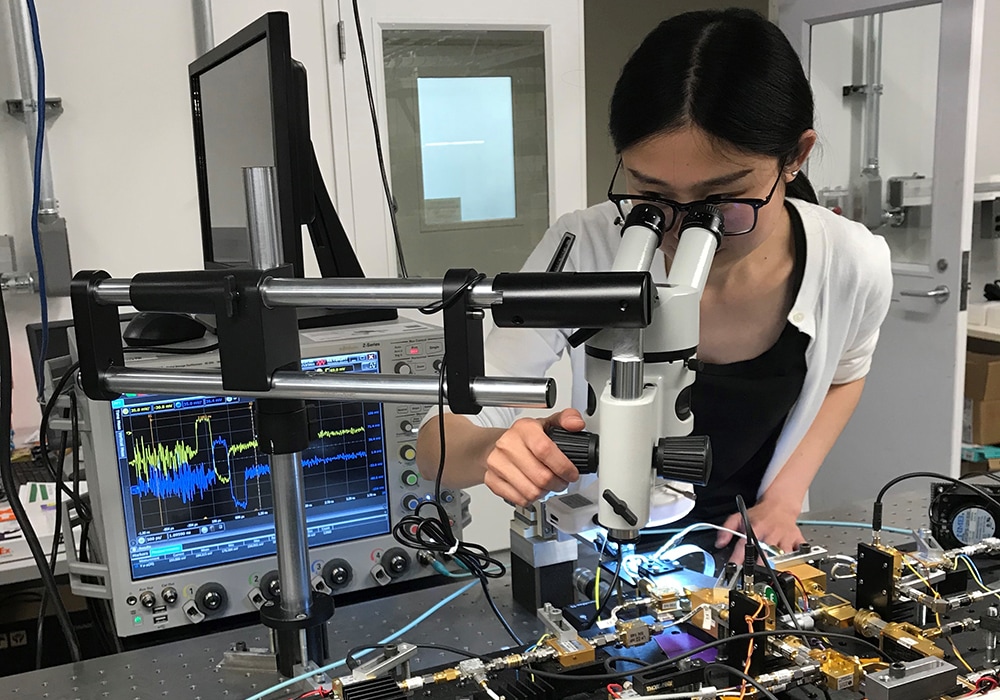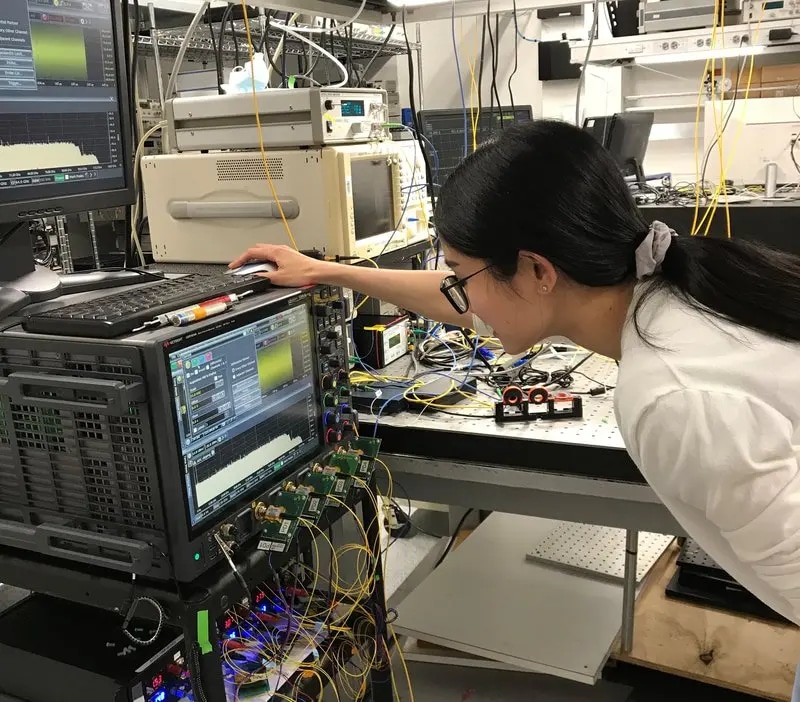Meet the fastest researcher in the optical world

Vivian Chen holds a unique world record for speed. No, she hasn’t surpassed Usain Bolt’s sub-10s time in the hundred meters. Nor has she achieved any new milestone in automobile, boat or aircraft velocity. Rather, Chen holds the world record for the fastest electronically generated multi-level optical signal at 200 gigabaud.
What does that mean exactly? Well, in the racetrack that is the optical network, speed is determined by how quickly a laser can “blink,” thereby sending light pulses down a strand of fiber. 200 gigabaud means 200 billion pulses of light per second. To put that in perspective, commercial fiber optics systems today generate just under 100 billion light pules per second, or 100 gigabaud.
And this is just one of the world records that Chen holds. Not only has she trained optical transmitters to blink faster, she has been able to encode more information into individual light pulses increasing the overall efficiency of each transmission. She has advanced the experimental state of the art through groundbreaking work with new classes of optical components. And while she has worked at Bell Labs for a mere six years, Chen has amassed an impressive publication portfolio. Of the more than 150 papers bearing her name, 15 are what are known as post-deadline papers, which carry particular significance in research circles. Post-deadline papers are the final papers accepted at major optical conferences like OFC and typically reveal major discoveries with the potential to shape the industry.
Chen has accomplished all this by the age of 34. Though her career may only be beginning, the impact of her work today will likely be felt for years to come. Ultimately the research Chen is doing in digital signal processing, modulation formats and fast signal generation will lead to higher-speed, higher-capacity and more-efficient networks. Her 200-gigabaud signal alone was able to support a transmission speed of 1.3 Tbps over a single optical wavelength. As these advances make their way into optical systems built by Nokia and others, they will extend the performance limits of our global communications infrastructure, meet the public’s insatiable demand for data, and empower the world to act together.

A puzzle to solve
Born in Hunan province, China, Chen first developed an interest in telecommunications systems as a student at National University of Defense Technology. The daughter of two mechanical engineers, Chen gravitated toward the sciences and for a while was contemplating a career in computer science. Ultimately, though she was drawn to communications.
“I was imagining my future as a coder, where my job would be writing algorithms and code in front of computer,” Chen said. “I didn’t feel sitting in front of a computer all day was that much fun. If I pursued telecommunications, I would also work with software, but I would have more of a chance to deal with hardware and components. I could go to lab and build something. I could put things together. I like the software part, but I want to do other things. It is a puzzle with more dimensions.”
In 2009 Chen migrated to Australia where she completed a PhD and post-doctorate fellowship at The University of Melbourne. That’s when the she came to the attention of Nokia Bell Labs. After completing an internship, Bell Labs luminary optical researcher Sethumadhavan Chandrasekhar recommended her for a position in his lab. The quintessential empiricist, Chandrasekhar was passionately performing experiments in his lab up to the day he retired in 2019, which made a deep impact on Chen.
It didn’t take long before Chen solved her first big puzzle. In her 2016 – only a year after joining Nokia Bell Labs – she published a paper demonstrating a 190-gigabaud signal, establishing her first world record (a record she improved upon again in 2019 with her 200 gigabaud research). A year later, Chen set new experimental milestones while working with a new class of optical receivers called Kramers-Kronig receivers, leading to several new Nokia patents.

In 2019, Chen established her next world record, this time in the area of high-spectral-efficiency constellations. If you think of Chen’s earlier work as her teaching a laser to blink faster, you can imagine her constellation research as teaching a laser to blink in more subtle ways.
“Modern optical communications is more sophisticated than just turning a light on off,” Chen said. “Power is just one of the physical dimensions of a light wave. It also has phase, and it also has polarization. In fibers that we use today, there are four dimensions we can modulate. The more we can manipulate those four dimensions the more information we can transmit over a single pulse.”
The sophistication of a constellation is measured in terms of quadrature amplitude modulation or QAM. The higher the QAM, the more bits can be encoded into a single pulse of light. In 2019, Chen demonstrated the successful transmission of a 16,384-QAM optical signal over 25 km of fiber. Each light pulse on that transmission carried 22 bits of information. That may not seem like much at first, but keep in mind the systems Chen is designing are sending billions upon billions of 22-bit pulses per second. To put her accomplishment in perspective, today’s state-of-the-art commercial optical infrastructure uses 64 QAM modulation, which can send 8 bits over a single pulse.
“Without a doubt, Vivian has experimentally demonstrated the highest-order optical QAM constellations ever – by a very big margin,” said Bob Tkach, Director of Photonics Research at Nokia Bell Labs and Chen’s current supervisor. “Vivian is an experimentalist by nature, but it’s not her only defining trait. Some of the best researchers blend theoretical and experimental approaches. Vivian strikes that balance well.”
In every connection there is always a bottleneck
While publishing papers and breaking world records are nice, Chen said one of her primary motivations for her research is curiosity. A tinkerer by nature, she enjoys taking things apart to see how they work and to see if she can improve them.
In the experiments that led to her world records, she approached the optical system as if it were a chain. “I was running tests on each individual step or link of the chain,” Chen said. “With every step, I detect how much the signal degrades and why it degrades. I then follow the whole chain to its end to see what I can find. Sometimes I find something big. Sometimes I find something small. Sometimes I don’t find anything at all. I just want to know what’s there.”

The remarkable thing about the spectral efficiency research Chen conducts is the fact she is constantly battling against an immutable law of physics. There is a fundamental limitation to the amount of information that can be sent over any communications channel. This ceiling is known as Shannon’s Limit, named after Nokia Bell Labs’ most famous mathematician Claude Shannon.
With every new increase in spectral efficiency, optical transmission gets closer and closer to reaching Shannon’s Limit. Consequently, some of the biggest trends in optical research are focused on multiple-core, multiple-fiber and multiple-mode systems – technologies that would increase the number of transmission channels rather than increase the efficiency of an individual channel.
When it comes to cramming more capacity into a single wavelength of light there are no more order-of-magnitude-gains to be had. But that doesn’t dissuade Chen from finding the bottlenecks that persist.
“When we talk about Shannon’s Limit, we’re talking about a fundamental level of noise that we will never overcome,” Chen said. “That’s the context we work in. However, there is other noise. There is noise from the transmitter, noise from the receiver, noise from the electronics. A lot of this noise is not necessarily fundamental. By distinguishing this noise from the fundamental noise, I can perhaps perform some tricks to squeeze a few more bits out of the transmitter and receiver.”
Chen may call them “tricks,” but the overall head of Optical Systems and Device Research at Nokia Bell Labs describes her contributions in far more eloquent terms. According to Lab Leader Tod Sizer, Chen exhibits a remarkable combination of cleverness and creativity in her approach to any problem, as well as strong willingness to collaborate with others.
“Vivian is one of the leading people in the industry in pushing the envelope in spectral efficiency,” Sizer said. “She has an uncanny understanding of the cost and complexity in how optical systems are built, and she has come up some very clever ways to convert information into light.”
Watch The Verge’s video featuring Vivian Chen and Tod Sizer discussing the future of optical communications:
